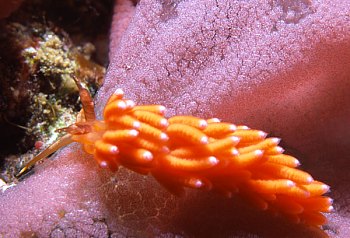
Favorinus cf. mirabilis
Baba, 1955
Order: NUDIBRANCHIA
Suborder: AEOLIDINA
Family: Glaucidae
PHOTO
NE Sulawesi, Indonesia, 13 July 2002. approx 15mm long. Photo: Jim Anderson.
Superficially this animal looks very like Favorinus tsuruganus, which is reported to feed on Hexabranchus eggs. However it differs in a number of features. Although they both have yellow digestive gland ducts in the cerata, in F. tsuruganus the body and the oral tentacles are opaque white and there is a black tip to the cerata, which is unlikely to be food related. Also the rhinophores seem to have four or more leaflets, rather than the three 'cup-shaped swellings' found in F. tsuruganus. In your animal the oral tentacles and the body are translucent orange and the tips of the cerata are white, not black. I suspect that this is a colour form of F. mirabilis. [See my comments in Jim Anderson's message. I have moved messages concerning Favorinus sp. 2 and Favorinus sp. 6 to this page as Favorinus cf. mirabilis.
Reference:
• Baba, K. (1955) Opisthobranchia of Sagami Bay. Supplement. Iwanami Shoten, Tokyo.
Rudman, W.B., 2002 (July 25) Favorinus cf. mirabilis Baba, 1955. [In] Sea Slug Forum. Australian Museum, Sydney. Available from http://www.seaslugforum.net/find/favocfmira
Related messages
Favorinus cf. mirabilis from Reunion Is.
February 3, 2009
From: Sully Bachel
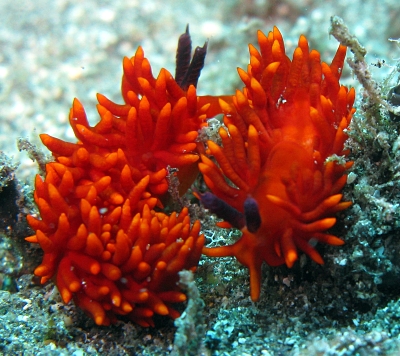
Concerning message #8260:
Dear Bill
I've found these Favorinus eating an hexabranchus egg. In fact there were three on the egg ribbon.
I think first that was Favorinus tsuruganus but according to P. Bidgrain, he thinks that it is Favorinus cf. mirabilis (no black tip on the cerata).
Locality: Cap la Houssaye, 8 m, Reunion Island, Indian Ocean, 14 January 2009. Length: 25 mm. Photographer: Sully Bachel.
Best regards
Sully Bachel
s.bachel@orange.fr
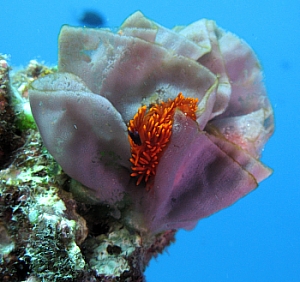
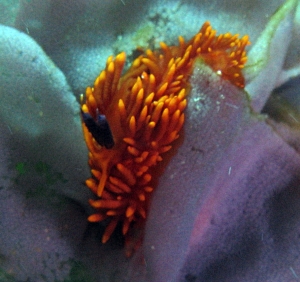
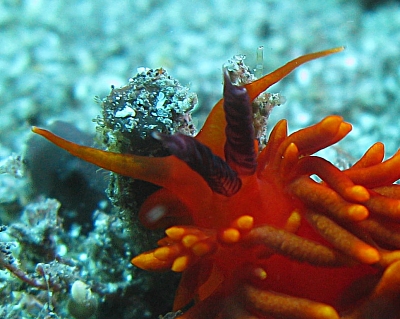
Dear Sully,
Yes this is the species I suspect is a colour form of F. mirabilis. Have a look on the Fact Sheet of F. cf. mirabilis and earlier messages, where I discuss the differences between it, F. tsuruganus and F. mirabilis.
Best wishes,
Bill Rudman
Favorinus cf. mirabilis eating Hexabranchus eggs
December 6, 2006
From: Ugo Gaggeri
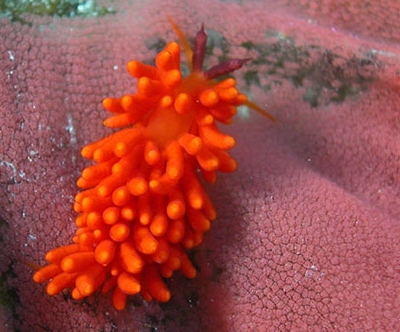
Concerning message #10871:
Dear Bill,
I found this similar-looking nudi on Hexabranchus eggs, but in Nosy Be, Madagascar. Maybe it is the same?
Locality: Nosy Be, about 15 m, Madagascar, Indian Ocean, November 2006. Length: about 10 mm. Photographer: Ugo Gaggeri.
Thank you!
Ugo
ugogaggeri@hotmail.com
Gaggeri, U., 2006 (Dec 6) Favorinus cf. mirabilis eating Hexabranchus eggs. [Message in] Sea Slug Forum. Australian Museum, Sydney. Available from http://www.seaslugforum.net/find/18892Dear Ugo,
I am afraid the photos in Yves Coze's message are not clear enough to be sure of the animal's identity so I tentatively identified it as F. japonicus. Your animal is definitely not that species and is one I am calling Favorinus cf mirabilis. We have a number of records of it feeding on Hexabranchus eggs. It seems a number of species of Favorinus feed on the eggs of Hexabranchus.
Best wishes,
Bill Rudman
Favorinus cf. mirabilis from Mayotte
December 15, 2003
From: Marina Poddubetskaia
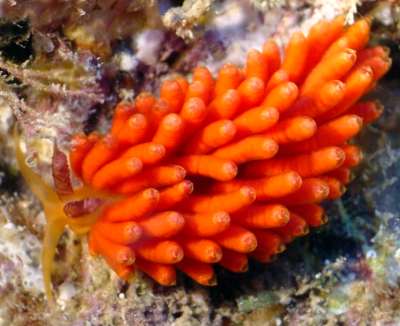
Dear Bill,
This species / variant was found on the same Hexabranchus egg-ribbon as the typical Favorinus mirabilis. And they really look like two distinct species. The egg-ribbon photo allows to see how they look different:
• Favorinus cf. mirabilis can be twice the length of Favorinus mirabilis
• the coloration of the body, cerata and rhinophores is very different too
There were many specimens of Favorinus mirabilis on the same egg-ribbon (see message 1). Photos of both species together on the egg ribbon are in a another message).
Date: November 14, 2003
Location: Mayotte Island, Indian Ocean
Site: Choizil
Depth: 19m
Size: 22-25mm
Cordially,
Marina.
nembro@nembro.info
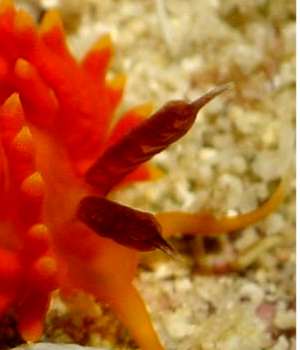
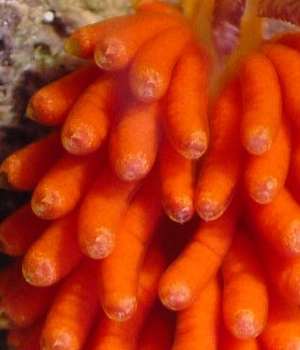
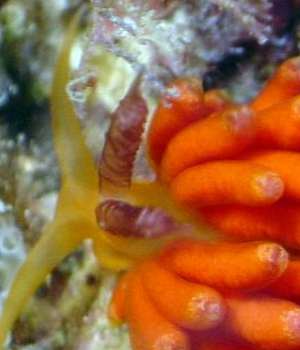
Thanks Marina,
As I have discussed in your other message, it is possible the size difference could be age related, but I think it is time t look at their anatomy
Best wishes
Bill Rudman.
Favorinus cf. mirabilis from Mauritius
November 13, 2002
From: Marina Poddubetskaia
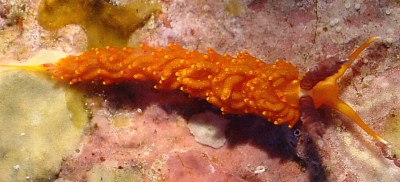
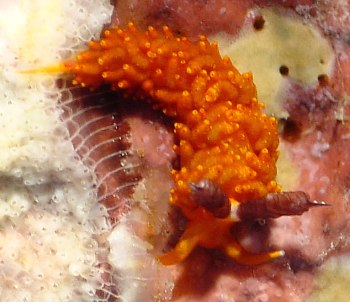
Dear Bill,
Do you recognize this nice eolid? I have no idea who is it. I found it in Mauritius.
What a shame, I haven’t any good shot of its rhinophores.
Pereybere, Mauritius, Indian Ocean. Site: Malen. Depth: 18m. Size: about 15mm. October 18, 2002. Photos: Marina Poddubetskaia - Nembro website
Best wishes,
Marina.
nembro@nembro.info
Poddubetskaia, M., 2002 (Nov 13) Favorinus cf. mirabilis from Mauritius. [Message in] Sea Slug Forum. Australian Museum, Sydney. Available from http://www.seaslugforum.net/find/8260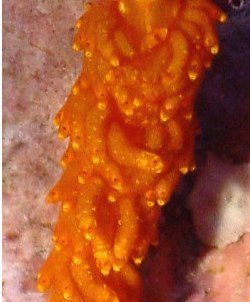
Dear Marina,
I am pretty sure this is the aeolid I have called Favorinus cf. mirabilis. As you see in my comments to earlier messages, in most respects it fits Favorinus mirabilis, but there are a few colour differences. At present we don't know if they fall into the normal variation found in the species. Your photo is quite helpful because it is the first of these orange-yellow animals which clearly shows the dark reddish spot near the tip of each ceras [see photo alongside], which is characteristic of Favorinus mirabilis. Another vote in favour of it being considered just a colour variation of that speces.
Best wishes,
Bill Rudman
Re: Favorinus cf. mirabilis
July 31, 2002
From: Jim Anderson
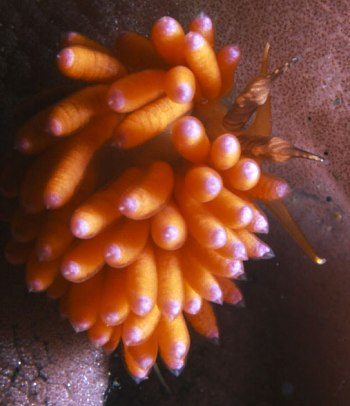
Dear Bill,
Thank you for the ID and information. Attached is a part image of another of the animals in the egg mass.
Kind regards,
Jim A
JAnder4454@aol.com
Anderson, J., 2002 (Jul 31) Re: Favorinus cf. mirabilis. [Message in] Sea Slug Forum. Australian Museum, Sydney. Available from http://www.seaslugforum.net/find/7663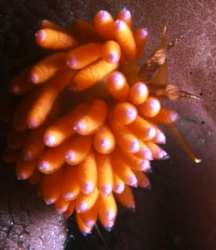
Dear Jim,
Thanks for the close up. I had hoped it would show the purple spot more clearly but I suspect its clearer at a smaller magnification. It certainly suggests Favorinus mirabilis but it would be nice to compare their radula and find a more 'typical' F. mirabilis without a white back or oral tentacles, or with a white tip to the cerata.
Cheers,
Bill Rudman
Favorinus eating Hexabranchus eggs
July 28, 2002
From: Jim Anderson

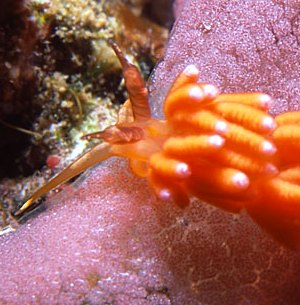
Dear Dr, Rudman,
The attached image shows? eating the egg spiral of Hexabranchus sanguineus This animal and two others were found in one of two adjacent egg masses found at 12.6 metres during a day dive. The second egg mass was unaffected. I have tried searching the forum but am unable to locate any identification info.
The slugs were approx 15mm long.
Dive site: DJ Point, N E Sulawesi, Indonesia
Date 13 July 2002.
Water temp: 29 deg C.
Thanks,
Jim A
jander4454@aol.com
Anderson, J., 2002 (Jul 28) Favorinus eating Hexabranchus eggs. [Message in] Sea Slug Forum. Australian Museum, Sydney. Available from http://www.seaslugforum.net/find/7615Dear Jim,
Thanks for these photo which may be a clue to a longterm identification puzzle on the Forum. Superficially your animal looks very like Favorinus tsuruganus, which is reported to feed on Hexabranchus eggs a number of times on the Forum. However it differs in a number of features. Although they both have yellow digestive gland ducts in the cerata, in F. tsuruganus the body and the oral tentacles are opaque white and there is a black tip to the cerata, which is unlikely to be food related. Also the rhinophores seem to have four or more leaflets, rather than the three 'cup-shaped swellings' found in F. tsuruganus. In your animal the oral tentacles and the body are translucent orange and the tips of the cerata are white, not black. This is the same species as an animal from Okinawa which was the subject of a very early message on the Forum from Bob Bolland which I called Favorinus sp. 2. The only difference is that in Bob's photo the rhinophres are very black but in yours they are orange with black 'dusting'. Interestingly Bob reports in his message that the rhinophores changed colour from orange to black between the time the animal was collected and when it was photographed. One species with the same shaped rhinophores is F. mirabilis and although the digestive gland colour is very variable, all animals I have seen have a reddish purple spot just down from the tip of each ceras. In the closeup of your photo these seems to be a spot in just the same space. My guess is that this is a colour form of F. mirabilis. If you could check your photos to see if you have a clearer photo of this spot I would be grateful.
Another animal which is probably the same is in Lindsay Warren's message from Madagascar. It differs in not having a white ceratal tip. However there certainly seems to be a trace of a light coloured region at the tip, perhaps obscured by skin pigmentation. All these problematic animals were found feeding on Hexabranchus eggs. Whether or not they are F. mirabilis, I am pretty sure that Favorinus sp. 2 and Favorinus sp. 6 are the same species, and probably F. mirabilis. I have therefore amalgamated them on this Favorinus cf. mirabilis Page.
Best wishes,
Bill Rudman
Favorinus sp. 2? from Madagascar
April 8, 2002
From: Lindsay Warren
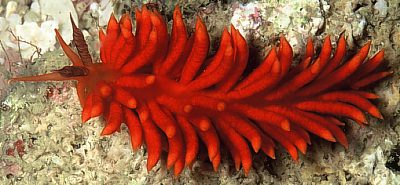
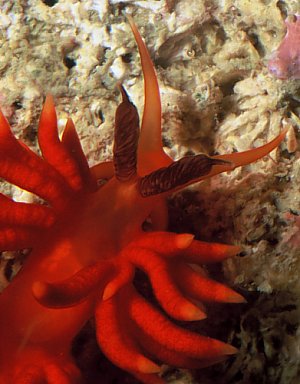
Dear Bill
Another find during my recent trip to Madagascar was this Favorinus which looks very similar to Favorinus sp. 2 on the Forum from Okinawa although the ones I found do not feature white tips to the cerata. The other difference is that all their rhinophores were black / very dark purple when I found them and this did not change when I collected them to observe further.
I found them while diving at Charlie's Point, Ile Sakatia, NW Madagascar on 24 January 2002 at 11.45am at a depth of 40 ft. They were crawling over a small detached, dead branching coral covered in various benthic organisms such as filamentous algae, sponges, bryozoans but no sign of eggs of any
kind. There were 7 in all - 3 measuring 30 mm and the 4 smaller ones between 20-25 mm. A regular local diver said that whenever he had seen them they were always on Hexabranchus sanguineus eggs but there were none where I found them. Photos: Lindsay Warren.
I would be interested to know if you think these are the same as Favorinus sp. 2 although I realise that unless the internal anatomy is examined it would be impossible to know for certain.
All the best
Lindsay
alldcl@compuserve.com
Warren, L., 2002 (Apr 8) Favorinus sp. 2? from Madagascar. [Message in] Sea Slug Forum. Australian Museum, Sydney. Available from http://www.seaslugforum.net/find/6220Note added 26 July 2002: I think this is probably a colour form of Favorinus mirabilis and have moved messages concerning Favorinus sp. 2 and Favorinus sp. 6 to Favorinus cf. mirabilis page.
Dear Lindsay,
They certainly have similarities to Favorinus sp. 2. There is a problem with using colour to identify species of Favorinus because at least the ceratal component can change depending on the colour of the eggs they are eating. There are a number of species which have these distinctive black rhinophores with the 'cup-like' lamellae - Favorinus mirabilis, Favorinus sp. 2, and Favorinus tsuruganus.
Your animal differs from all of them in small colour details which are do not appear to be food related. One of these, F. tsuruganus, is reported on the Forum to eat Hexabranchus eggs, so it could be that species, without the black tips to the cerata, or it could be another species which also eats Hexabranchus eggs. The radula of species of Favorinus is very similar, and there is some evidence to suggest that denticles can be present or absent in the same species. I suspect we have a way to go before we can be confident with our taxonomy of this genus.
I think I will call this Favorinus sp. 6.
Best wishes,
Bill Rudman
Favorinus from Okinawa
September 4, 1998
From: Bob Bolland
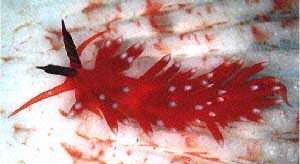
Bill,
Here is a scan of a delightful aeolid (Favorinus?) from Okinawa. This is the first time I've seen this beautiful animal. It was collected by US Navy Cmdr. Keven Reed on 7 June, 1998 from Horseshoe Cliffs in 21 plus meters. The animal was found on a Hexabranchus egg ribbon. According to Keven, at the time the animal was collected, the rhinophores were the same color as the cerata. The animal was then placed in a home aquarium until it was given to me twelve days later, whereupon I took the accompanying photograph. The rhinophores changed from red to black from the time it was collected until the time it was photographed (TL: 22mm). I'm not sure whether the color change was rapid or done in slow increments.
Was the color change due to stress from within the aquarium, or do other factors play a roll in this?
Bob Bolland
OKINAWA, 21 August 1998
bolland@imicom.or.jp
Bolland, R.F., 1998 (Sep 4) Favorinus from Okinawa. [Message in] Sea Slug Forum. Australian Museum, Sydney. Available from http://www.seaslugforum.net/find/224Note added 26 July 2002: I think this is probably a colour form of Favorinus mirabilis and have moved messages concerning Favorinus sp. 2 and Favorinus sp. 6 to Favorinus cf. mirabilis page.
Dear Bob,
It certainly looks like a Favorinus and being on another opisthobranch's eggs is a pretty good sign its a Favorinus, for as you know opisthobranch egg eating is a characteristic of the genus. Its black ridged rhinophores certainly look a bit like those of Favorinus tsuruganus Baba & Abe, 1964, but that species is essentially yellow with black-tipped cerata.
Concerning colour changes. Some species such as Favorinus japonicus change colour depending on the colour of the eggs they are feeding on. But the colour change is due to the colour change of the gut contents not the skin pigment. As the rhinophore colour is probably skin pigmentation I'm not sure why it changed to black.
Bill Rudman
